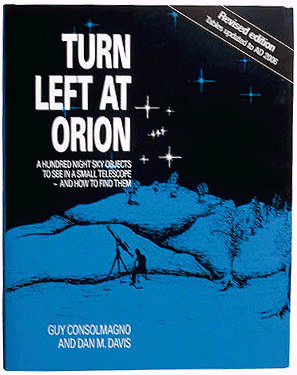Observing Guides




 Purchasing Information |
Turn Left At Orion, 2nd Edition
By Guy Consolmagno and Dan M. Davis An excellent book specifically designed for small telescope owners. If you just bought a new telescope and you decide to buy only one book, make it this one. I think this book should come with every new telescope! It shows you how to find over 100 of the best objects in the sky, including star clusters, galaxies, nebulae, and double stars. The book provides easy-to-use finder charts and detailed instructions on where to point and how to move the telescope. Couple that with accurate drawings of what each object will look like through the eyepiece and finderscope, and you've got a book that ensures you'll spend less time hunting objects and more time observing them. The book also discusses lunar and planetary observing and general observing tips.
|
 Purchasing Information |
Deep Sky Companions: The Messier Objects
By Stephen J. O'Meara This is a nearly perfect guidebook for anyone interested in observing and learning about the Messier objects, which are some of the best star clusters, galaxies, and nebulae in the sky. The author provides background information on each of the 110 Messier objects, including excepts from Charles Messier's own observations from the 18th century. In addition, the author provides a photograph, a star map showing the object's location, and his own drawing of the object so you can see just what to expect through the eyepiece of a telescope. This book is particularly suited for small telescope users and beginners because the author based all the drawings and descriptions in the book on his observations using a 4-inch telescope. The entire book is very easy to read, and the author's writing style in very personable. This is the most complete book I've seen on this very popular list of objects!
|
 |
Norton's Star Atlas and Reference Handbook, 19th Edition
Edited By Ian Ridpath This is an excellent reference book that has stood the test of time and has become a classic among backyard astronomers. This most recent edition was released in August of 1998, adding the most up-to-date astronomical information to an already near perfect reference book. As the name implies, one of the main components of Norton's is a series of excellent star charts which cover the entire night sky for both the northern and southern hemisphere. The charts show all stars down to magnitude +6.0 and over 600 deep sky objects, including the entire Messier catalogue. Accompanying each chart is a list of interesting objects that can be found on that chart, such as double stars, variable stars, nebulae, clusters, and galaxies. But Norton's is more than a set of star charts; the reference portion of this book contains a tremendous wealth of information about the solar system, observing, astrophotography, stellar evolution, general astronomical principles, and much more. Both the star charts and the reference section are perfect for beginners; in fact, you will find that you will continue to refer to it as a more advanced amateur!
|
 Purchasing Information |
The Backyard Astronomer's Guide
By Terence Dickinson and Alan Dyer A tremendous, comprehensive guide to amateur astronomy that covers just about everything! The text includes practical information about choosing and using binoculars, telescopes, and accessories, plus tips for observing virtually every type of sky phenomena or object. Astrophotography is also covered. The book is very easy to read and is intended for people just getting started.
|
 Purchasing Information |
365 Starry Nights
By Chet Raymo A unique book that can serve as a wonderful introduction to astronomy for young beginners in astronomy. The text is arranged into daily brief, concise discussions of stargazing topics appropriate for objects visible that night. The book is generously illustrated, with star charts and drawings appearing on virtually every page. Striking a balance between both the aesthetic and scientific aspects of astronomy, the easy to read text offers up-to-date information and helpful hints on how to observe the stars, some interesting history and anecdotes about objects, and methods of calculating stellar age, brightness, distance, and much more. 365 Starry Nights is an appropriate book for telescope, binocular, or even naked-eye observers.
|
Privacy is surely a very important consideration to you, and Amazon.com protects personal information as a matter of policy.
